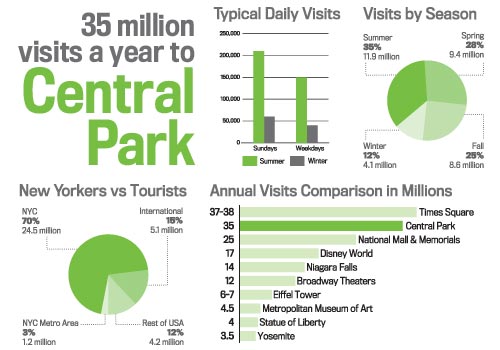Manage Rock Creek like Central Park or Yosemite?
New Yorkers and Washingtonians are both blessed with a large protected park in the middle of town. In fact, Rock Creek Park is over twice as large as Central Park.
So why does Central Park get used 17 times more often than Rock Creek Park?
Sure, there are more visitors to NYC than to Washington, but the number of visits to Central Park by New Yorkers alone is equal to the total number of visits to Washington’s Mall and monuments by everyone (25 million per year).
Rock Creek Park, by comparison, gets 2 million visits per year, making it the 32nd most visited urban park in America. It edged out Audobon Park in New Orleans, a metro area 1/4 the size of Washington.
Both parks were design projects of Frederick Olmsted in the late 1800s. Both parks offer roughly the same activities to visitors.
So why is the larger park used so much less than the smaller park?
Could it have something to do with the transfer of control of Rock Creek Park to the National Park Service in 1933, whereas Central Park is managed by a conservancy on contract with the city?
With the National Park Service currently planning a rehabilitation of its 3.7 mile trail, now is a good time to envision what our park could really become.
Which of the following features of Central Park would be impossible to have in Rock Creek Park, despite being present in Central Park?
- Traffic banned after 7pm and on weekends (Rock Creek has partial closures on weekends)
- 25 mph speed limit (Rock Creek Parkway is 35 mph)
- 21 playgrounds
- 9,000 benches
- 58 miles of trails (25 miles in Rock Creek)
If New York City can support these features in Central Park, then the National Park Service can support them in Rock Creek Park as well.
But what can realistically be done?
Requests for these types of features have fallen on deaf ears at NPS before. And it seems unlikely that NPS will transfer control of Rock Creek Park over to the DC Parks and Recreation Department, particularly since the park crosses state lines.
The solution may be to establish a Rock Creek Park Conservancy to manage the park under contract with NPS. The Friends of Pierce Mill is currently raising money for a study to assess the feasibility of a conservancy for Rock Creek Park.
Interestingly, Central Park was saved from years of decline by the creation of the Central Park Conservancy in 1980 by a group of civic and philanthropic leaders. Today, the Conservancy’s mission is “to restore, manage and enhance Central Park, in partnership with the public, for the enjoyment of present and future generations”.
It seems more likely that NPS would agree to contract out management of Rock Creek Park to a conservancy than to relinquish control of the park to local governments. By leveraging the underused oasis that is in our midst, few initiatives would do more to make Washington a more livable, walkable city.

